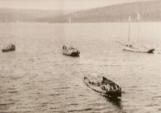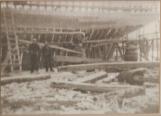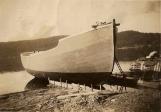2
The history of the Bay d'Espoir area offers an interesting contrast to that of areas surrounding the South Coast, in that it is not so much associated with making a living from the sea but more closely linked to the land; in particular, logging and shipbuilding. The need for masts for sailing ships brought the early loggers to Bay d'Espoir as the forest was a great source of tall trees, thirty to fifty feet in height.Because the South Coast was generally devoid of forests, winter crews frequented Head of Bay d'Espoir for its abundant supply of timber. By 1835, the main merchants that sent crews were Newman & Company with headquarters in Harbour Breton and Nicoll & Company with headquarters in Jersey Harbour, both had other establishments along the South Coast. The timber that was taken from Bay d'Espoir was mainly used for shipbuilding. Other orders for timber included frames, boards, clapboard and shingles for the building of houses and a variety of outbuildings and fishing premises, staves and hoops for barrels used in the fishery and planks and logs for wharf construction and repair.
4
Eventually some of the loggers from these merchant crews decided to settle in Bay d'Espoir. Before Confederation, sawmilling and shipbuilding were the industries providing most of the employment in the Bay d'Espoir region. In addition to the exporting of planks and other wood products, a major shipbuilding industry grew. Many of these vessels, primarily two and three masted schooners were used in the fishing industry on the South Coast, as well as, for trade in various goods (timber products, food stuffs, etc.) along the coast and with nearby St. Pierre; which in turn provided additional employment opportunities for local residents as crews on these vessels.9
In the winter five or six men would work on a schooner, all this work was done outside with no shelter. The only source of light used when working after dark was the old fashion hurricane lamp. In the summer there were more workers because the schooner had to be corked and painted. Different trees were used for different parts of shipbuilding. The principle tree from which ships timbers, keels, stems and planks for shipbuilding and repair were obtained was the yellow birch, locally called the witch hazel. Only the heartwood part of that species was used. Heartwood is the core or central portion of a tree trunk, which is dead and is more durable than the sapwood or live portion. The live part of the trunk was chopped away where the tree was felled. Axes and pitsaws were then used to shape the exposed heartwood into pieces somewhat larger than ultimately required for shipbuilding. All frame work was done by axe. The white spruce, renowned for its size, straightness and strength, was in great demand for ship's masts. The durable tamarack was also used for ship's masts but due to its scarcity its use was restricted to ships planking.11
In 1894, the Lakes from Fortune, established the first sawmill in Milltown. The Lake's business began in 1868 based on the fishery and later expanded into shipbuilding and furniture manufacturing. The Lakes however, only built two schooners, during their years of operation in Milltown. The Rameux and Tweedsmuir were both built in 1935 at Frank's Brook, located near the Lake's mill.13
In 1907, two brothers Morgan and Wilson Roberts started a sawmill in Head Bay d'Espoir. In later years, Morgan, who had worked in San Francisco in the shipyards, added shipbuilding to the brothers sawmill business. Their first schooner was built in 1912 and was named "The Roberts Brothers". Between 1912 and 1947 the Roberts built 53 schooners, the very last was the Shirley Blanche. The brothers were well known on the South Coast for building schooners and they were great contributors to the local economy. All schooners, except four, were built from models. These four were draggers built for Fishery Products International, which were made from blueprints. These draggers were the first FPI ever had.14
The Roberts brothers weren't the only shipbuilders in Bay d'Espoir. The Kendell brothers had a sawmill and shipbuilding business in Morrisville. John W. Kendell came from Piccarie to Milltown when he was 17 or 18 years old. He was one of the first loggers that was employed by Lake's Mill. While living in Milltown he met and married Elizabeth Ann Roberts. He then went to work for his in-laws but a disagreement arose and John left the Roberts' business to start his own mill. In 1912, John and his two brothers, James and Albert, started their own mill in Morrisville, which was called Lynch's Cove at the time after a Jersey fisherman that drowned there. The sawmill was powered by a steam engine (a water boiler that produced steam to work the engine).At first the Kendell brothers lived in Milltown and operated the sawmill in the summer but later they settled permanently in Lynch's Cove. After settling, the Kendells renamed Lynch's Cove to Morrisville, named after the 12th Prime Minister of Newfoundland at the time, Sir Edward Patrick Morris.
During the period he spent working for the Roberts brothers, John learned from Morgan how to build schooners and in 1914, John and his two brothers started building their own two-masted schooners. Their shipbuilding business was on a smaller scale than the Roberts, but they did build a number of schooners that varied from 25-40 tons with the exception of one which was 91-92 tons. Most of the schooners were spoken for before they were built as was the case for most shipbuilders in the area. The last boat built by the Kendells was the A.L. Roy, which was named after three of John's grandchildren. The Kendells continued business until the mid to late 1940's.






